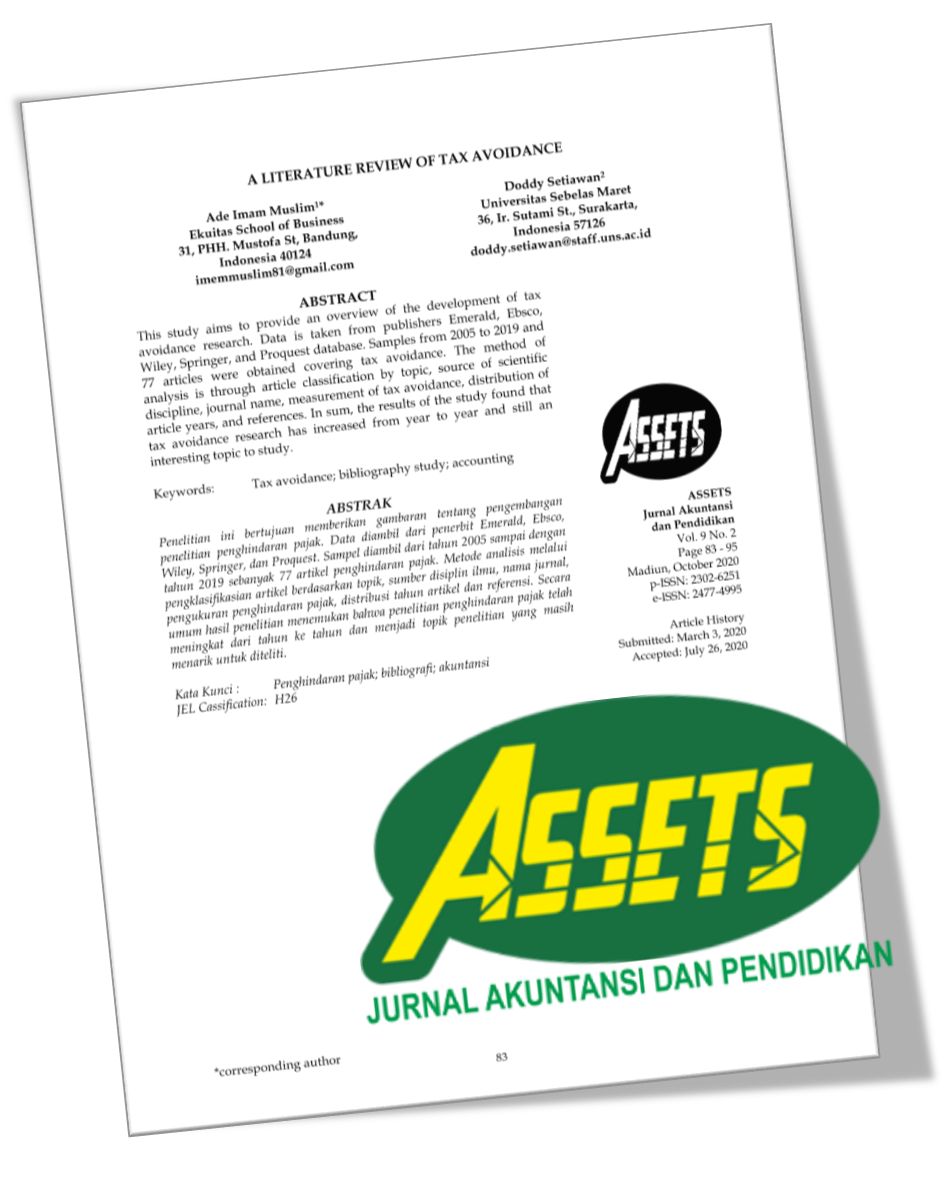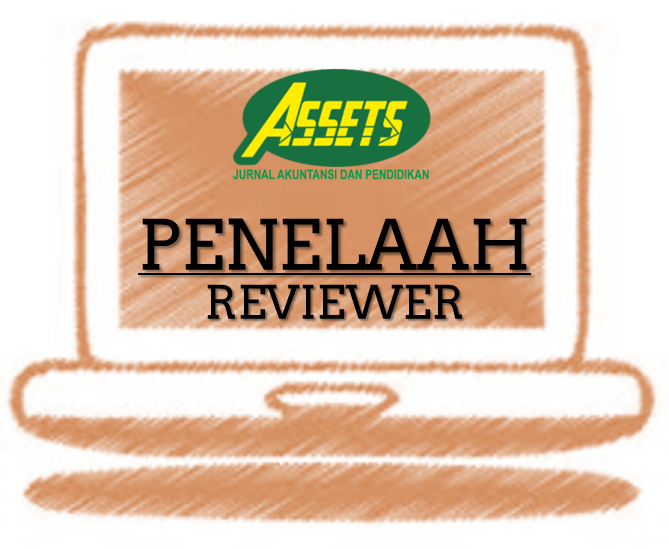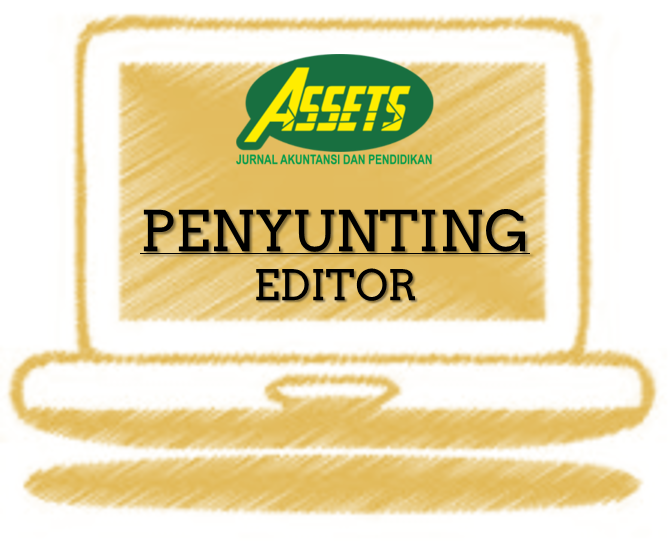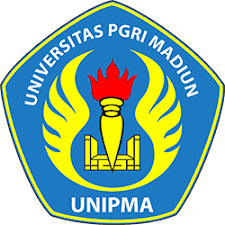Author Guidelines
Redaksi menerima naskah dengan bidang kajian ilmu akuntansi dan pendidikan akuntansi yang bertemakan:
- akuntansi keuangan,
- akuntansi manajemen,
- akuntansi sektor publik,
- sistem informasi akuntansi,
- pengauditan,
- perpajakan,
- akuntansi syariah,
- akuntansi kewirausahaan,
- akuntansi perbankan,
- inovasi pembelajaran akuntansi,
yang memakai metodologi penelitian dengan paradigma:
- positif (baik berbentuk kuantitatif dan kualitatif),
- interpretif,
- kritis,
- posmodern,
- spiritual/religius.
dengan panjang artikel minimal 15 halaman dan maksimal 40 halaman (termasuk lampiran), dengan ukuran kertas A4 spasi 1,15. Artikel diketik dalam format Microsoft Word. Judul, subjudul, isi artikel kecuali nama penulis dan isi abstrak diketik dengan tipe huruf Book Antiqua 11pt. Isi abstrak dan kata kunci, serta nama penulis diketik dengan tipe huruf Book Antiqua ukuran 10 pt. Setiap istilah asing wajib ditulis memakai huruf italic. Batas pengetikan adalah 3,5 cm untuk sisi kiri, serta 2,5 cm untuk sisi kanan, atas, dan bawah.
Sistematika penulisan terdiri dari judul, nama penulis, abstrak, pendahuluan, metode, hasil dan pembahasan, simpulan dan saran, serta daftar pustaka. Penjelasan masing-masing bagian adalah sebagai berikut:
a. Judul artikel berbahasa Indonesia maksimal terdiri dari 12 kata yang menunjukkan hal atau topik yang diteliti. Penulisan judul, subjudul Abstrak dan Abstract memakai huruf kapital, dengan huruf tebal dan rata tengah. Sub judul (Pendahuluan, Metode Penelitian, Hasil Penelitian dan Pembahasan, Simpulan, Daftar Pustaka) memakai huruf kapital, dengan huruf tebal dan rata kiri.
b. Nama penulis ditulis lengkap tanpa gelar, diikuti nama institusi asal penulis. Jika penulis terdiri lebih dari satu penulis, maka hanya penulis utama yang mencantumkan alamat surel.
c. Abstrak dan kata kunci ditulis dalam Bahasa Inggris dan Bahasa Indonesia. Abstrak terdiri dari 75 - 100 kata, satu paragraf dan diketik satu spasi. Abstrak Bahasa Inggris memakai huruf miring (italic). Abstrak minimal berisi tujuan, metode, dan hasil penelitian. Kata kunci terdiri dari 3-5 kata yang merupakan intisari penelitian dan kata populer, antar kata kunci dipisahkan dengan titik koma (;).
d. Pendahuluan
Penelitian yang menggunakan metodologi positif (berdasarkan teori), baik berbentuk kuantitatif maupun kualitatif, mencantumkan gejala dan fenomena yang mendasari pelaksanaan penelitian, tujuan penelitian, teori yang dijadikan dasar untuk menjawab masalah, justifikasi penggunaan teori, dasar penggunaan tempat atau populasi penelitian dan rentang waktu penelitian. Teori dapat didukung oleh hasil penelitian terdahulu yang disebutkan secara ringkas sehingga peneliti dapat menunjukkan kebaruan penelitiannya. Kontribusi penelitian secara teoritis dan praktis ditunjukkan pada bagian akhir.
Penelitian yang menggunakan metodologi nonpositif mencatumkan masalah inti berdasarkan fenomena yang terjadi dan pendapat para ahli atau peneliti yang berbentuk cerita atau dialogis. Dasar pemilihan objek penelitian disertakan pada bagian ini. Jika ada penelitian terdahulu yang membahas tema sama, maka peneliti dapat menceritakan secara ringkas pada pendahuluan. Kontribusi penelitian secara praktis ditunjukkan pada bagian akhir.
Judul tabel dan grafik diletakkan di atas tabel dan grafik, sedangkan judul gambar diletakkan di bawah gambar. Judul tabel, grafik, dan gambar dicetak tebal dan berada di tengah (center). Baik tabel, grafik, dan gambar harus menyertakan sumber yang diperlakukan sama seperti sitasi. Jika sumber berasal dari analisis yang dilakukan peneliti, maka penulis tidak perlu menyertakan sumber. Sumber tabel, grafik, dan gambar dicetak tebal dan diketik rata kiri.
e. Metode Penelitian
Bagian ini menjelaskan metodologi penelitian (positif atau nonpositif, misalnya interpretif, posmodern, kritis, spiritual), bentuk penelitian (kuantitatif atau kualitatif), metode pengumpulan data (jika data primer berupa wawancara, jika sekunder berupa data laporan keuangan), objek penelitian (populasi dan sampel atau reponden yang digunakan jika positivistik, informan yang digunakan pada non-positivistik), teknik pengumpulan dan analisis data.
f. Hasil Penelitian dan Pembahasan
Bagian ini menjelaskan hasil penelitian (misalnya tabel hasil uji statistik yang sudah diringkas sesuai kebutuhan pembaca untuk penelitian kuantitatif atau kutipan wawancara yang dianalisa untuk penelitian kualitatif) disertai pembahasan secara mendalam dan kritis.
g. Simpulan
Bagian ini berisi simpulan tentang inti temuan dalam penelitian, kelemahan penelitian yang merupakan kekurangan yang dijumpai peneliti pada saat pelaksanaan riset, serta saran untuk penelitian mendatang.
h. Daftar Pustaka
Daftar pustaka berisi rujukan yang digunakan peneliti dalam artikel yang terdiri dari 80% rujukan primer seperti jurnal dan prosiding. Jurnal maupun buku yang dijadikan rujukan merupakan terbitan 10 tahun terakhir. Gaya penulisan daftar pustaka menggunakan American Psychological Association (APA) 7th edition. Contoh penulisan sitasi dan referensi ada pada bagian selanjutnya.
i. Lampiran
Lampiran bersifat tidak wajib, artinya lampiran hanya ada jika peneliti merasa perlu untuk melampirkan instrumen penelitian, misalnya kuesioner. Hasil perhitungan statistik tidak masuk pada lampiran, namun hanya diperlakukan sebagai bahan review substansi oleh tim editor.
Berikut contoh penulisan sitasi pada teks:
Buku:
.... penggunaan analisis menggunakan Warp PLS (Abdillah dan Hartono, 2015: 25). Abdillah & Hartono (2015: 25) lebih lanjut menyatakan bahwa...
Jurnal, artikel daring, dan prosiding:
...yang digunakan dalam berbagai penelitian keperilakuan (Achmat: 2013). Achmat (2013) juga menjelaskan tentang...
Penulis diharapkan menggunakan alat bantu sitasi seperti mendeley. Berikut contoh penulisan referensi:
Buku:
Abdillah, W., dan Hartono, J. (2015). Partial Least Square (PLS) - Alternatif Structural Equation Modeling (SEM) dalam Penelitian Bisnis. Yogyakarta: Penerbit Andi.
Artikel daring:
Achmat, Z. (2013). Theory of Planned Behavior, Masihkah Relevan? Diunduh pada 30 Januari 2016, dari http://zakarija.staff.umm.ac.id/files/2010/12/Theory-of-Planned-Behaviormasihkah-relevan.pdf.
Anonim. (2015). Ditjen Pajak Rencanakan Terapkan Kebijakan Tax Amnesty di Tahun 2017. Diunduh pada 15 Oktober 2015, dari http://www.pajak.go.id/content/news/ditjen-pajak-rencanakan-terapkan-kebijakan-tax-amnesty-di-tahun-2017.
Jurnal:
Allingham, M. G., dan Sandmo, A. (1972). Income Tax Evasion: A Theoretical Analysis. Journal of Public Economics, 1, 323–338.
Prosiding:
Aneswari, Y. R., Darmayasa, I. N., dan Yusdita, E. E. (2015). Perspektif Kritis Penerapan Pajak Penghasilan 1% pada UMKM. Simposium Nasional Perpajakan 5 (1–22). Universitas Trunojoyo Madura.
Naskah harus disimpan dan diunggah menggunakan format microsoft office 1997-2003.
-------------------------------------
The editorial received a script with the field of study of accounting science and accounting education in these themes:
A. Financial Accounting,
B. Management accounting,
C. Public sector accounting,
D. Accounting information system,
E. Auditing,
F. Taxation,
G. Accounting Sharia,
H. Entrepreneurial accounting,
I. Banking accounting,
J. Innovation in accounting learning,
K. Accounting Education,
L. Accounting in SMEs.
Which used the research methodology with one of these paradigms:
A. Positive (both quantitative and qualitative),
B. Interpretive,
C. Critical,
D. Posmodern,
E. Spiritual / Religious,
With an article length of at least ten pages and a maximum of 40 pages (including attachments), A4 paper size with 1,15 spacing. Articles are typed in Microsoft Word format. Title, subtitle, article content, except author name and abstract contents, typed with Book Antiqua 11pt letter type. Abstract contents, keywords, and author names are typed with Book Antiqua 10pt letter type. Every outside term must be written using italic letters. The margin is 3,5 cm for the left side and 2,5 cm for the right side, top, and bottom.
Systematic writing includes title, author name, abstract, introduction, method, results and discussion, conclusions and suggestions, and reference. Explanation of each section is as follows:
A. The maximum word count of an Indonesian title is 12 words that indicate the subject matter or topic studied. The title and abstract are written in capital and bold letters, aligned left. Subtitles (Introduction, Research Methods, Research Results and Discussion, Conclusions, Reference) are also in capital letters, bold letters, and aligned left.
B. The author's name is written entirely without the educational degree, followed by the name of the author's affiliation. If there is more than one author, only the primary author includes the email address.
C. Abstracts and keywords are written in English and Indonesian. The abstract comprises 75 - 100 words in a paragraph with one spacing—abstract English using italics. The abstract contains at least the research objectives, methods, and results. Keywords consist of 3-5 words, the essence of research and famous words, between keywords separated by semicolons (;).
D. Introduction
Research using positive (theory-based) methodology, both quantitative and qualitative, includes symptoms and phenomena underlying the conduct of research, research objectives, theories used as the basis for answering problems, justification of theoretical use, the rationale for the use of places or research populations and the period of the study. The theory can be supported by the results of previous studies mentioned briefly so that researchers can show the novelty of his research. The contribution of theoretical and practical research is shown at the end.
Research using nonpositive methodology states core issues based on the phenomena that occur and the opinions of scholars or researchers in the form of stories or dialogue. Justification of the selection of research objects is included in this section. If there are previous studies that discuss the same theme, then researchers can briefly explain the introduction. The contribution of the research is practically shown at the end.
Tables and charts are above tables and graphs, while the image's title is under the image. Table titles, graphs, and images are bold and centered. Tables, graphics, and photos must include the data source treated as the citation. If the source comes from the researcher's analysis, then the author does not need to include the source. The source of the tables, graphics, and images is bolded and left-aligned.
E. Research methods
This section describes the research methodology (positive or nonpositive, e.g., interpretive, postmodern, critical, spiritual), the form of research (quantitative or qualitative), data collection methods (interviews as primary data, financial statements as secondary data), research object (the sample or respondent used for positivistic and informant used for nonpositivistic), data collection techniques and analysis.
F. Research Results and Discussion
This section describes the study's results (e.g., statistical test tables that have been summarized as needed by the reader for quantitative research or interview quotes analyzed for qualitative research) with in-depth and critical discussion.
G. Conclusion
This section contains the conclusions about the study's core findings, the weaknesses of the research, the shortcomings that researchers encountered during the research, and suggestions for future research.
H. Bibliography
The bibliography contains references researchers use in articles, and 80% are primary referrals such as journals and proceedings. The journal and the reference book are the last ten years. Literature writing style using the American Psychological Association (APA) 6th edition. Examples of citation and reference writing are in the next section.
I. Appendix
The appendix is not mandatory, meaning it only exists if the researcher must attach a research instrument, such as a questionnaire. The results of statistical calculations are not included in the appendix but are treated only as substance review material by the editor team.
It is recommended that the author use reference tools such as Mendeley. Here are some examples of citation writing on text:
Book:
...the data analysis using Warp PLS (Abdillah dan Hartono, 2015: 25). Abdillah & Hartono (2015: 25) also state that...
Journal, online article, and providing:
...that is used in several behavioral research studies (Achmat, 2013). Achmat (2013) also explains that...
Here are some examples of bibliography writing:
Book:
Abdillah, W., dan Hartono, J. (2015). Partial Least Square (PLS) - Alternatif Structural Equation Modeling (SEM) dalam Penelitian Bisnis. Yogyakarta: Penerbit Andi.
Online article:
Achmat, Z. (2013). Theory of Planned Behavior, Masihkah Relevan? Diunduh pada 30 Januari 2016, dari http://zakarija.staff.umm.ac.id/files/2010/12/Theory-of-Planned-Behaviormasihkah-relevan.pdf.
Anonim. (2015). Ditjen Pajak Rencanakan Terapkan Kebijakan Tax Amnesty di Tahun 2017. Diunduh pada 15 Oktober 2015, dari http://www.pajak.go.id/content/news/ditjen-pajak-rencanakan-terapkan-kebijakan-tax-amnesty-di-tahun-2017.
Journal:
Allingham, M. G., dan Sandmo, A. (1972). Income Tax Evasion: A Theoretical Analysis. Journal of Public Economics, 1, 323–338.
Proceeding:
Aneswari, Y. R., Darmayasa, I. N., dan Yusdita, E. E. (2015). Perspektif Kritis Penerapan Pajak Penghasilan 1% pada UMKM. Simposium Nasional Perpajakan 5 (1–22). Universitas Trunojoyo Madura.
The manuscript must be saved as a Microsoft Office document from 1997 to 2003.












